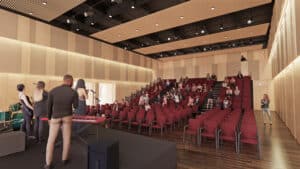
The 26,500-square-foot La CASA in Boston’s South End will become the largest Latinx Cultural Center in New England. Image courtesy of Studio Enée
Boston’s new home for Latinx art and community empowerment, La CASA the Center for the Arts, Self-Determination, and Activism is centrally located in Boston’s Historic South End.
La CASA will be the heart of arts programming and community-building initiatives belonging to Inquilinos Boricuas en Acción’s (IBA), a nonprofit organization and community development corporation focused on preserving and strengthening Boston’s diverse communities.
Designed by Studio Enée architects in collaboration with Annum Architects, the new 4-story, 26,500-square-foot building is under construction, and will be the largest Latinx cultural center in New England.
The $25 million construction cost includes galleries and spaces for arts education, performance, and community gatherings with a multi-purpose community arts space on the first level. It will also include flexible spaces for programs, services, property management and community activities.

A multipurpose room at La CASA will host community gatherings and music, dance and theater events. Image courtesy of Studio Enée
A New Magnet for Arts and Culture
The project vision prioritizes creating a welcoming, transparent and vibrant building dedicated to arts programs while promoting and preserving the Latinx arts and culture in the community.
In addition to being a hub for IBA’s programs and operations, the building will create physical connections to the adjacent O’Day Playground and be a good neighbor to the South End district, sharing access to its rich array of arts programs. A critical piece of the design of the building is to represent the identity of the Latinx diaspora in Boston within the context of the historic South End neighborhood.
Since 1898, a church occupied the site at 85 West Newton St. For the past 30 years, IBA repurposed the church as the Villa Victoria Center of the Arts, a community center and the hub for Latinx arts and cultural programming.
In 2020, during renovations to the historic church, extensive structural deficiencies were discovered, and significant parts of the building were required to be completely rebuilt. IBA salvaged significant historic components of the building, which connects parts of the organization’s storied past to its future.
Salvaged elements include granite from the base of the building that will be incorporated at the first-floor lobby and stained-glass windows, which will be displayed in a gallery inside the new building to honor the legacy of the church and the history of the site.
Inspired by Island, Local History
The design for La CASA was inspired by the architecture of Puerto Rico.
The exterior brick and terracotta façade is influenced by the articulated masonry represented in 20th century Puerto Rican architecture, which allows for sun and natural light to be diffused throughout the building.
The brick, consistent with the Victorian row houses on West Newton Street, constitutes the main envelope of La CASA. A veil of terracotta wraps the upper portion of the building on West Newton Street and compliments the scale and color of the adjacent brick context.
A glass curtain wall at the street level and against O’Day Park creates a welcoming and transparent entrance to the building and invites the public into the bright and vibrant spaces inside.

Natasha Espada
The multipurpose room will host music, dance, theater and community gatherings. From the multi-purpose room, glass doors open onto the park and create a proscenium. An upper terrace over the multipurpose room overlooks O’Day Park and creates an additional exterior gathering space for the community. The building serves as a backdrop for cultural activities and a public art mural enhances the connection to the vibrant local community.
IBA emerged in the 1960s when the organization successfully fought the displacement of Puerto Rican families in the South End due to gentrification and established Villa Victoria, a neighborhood of high-quality affordable housing. Today, IBA continues that work, with an emphasis on the Latinx community, by offering and advocating for high-quality affordable housing, community building through arts and culture programming and educational opportunities that empower youth, individuals and families to achieve socio-economic mobility.
La CASA will be funded by philanthropy support, new market tax credits, bond financing and a congressional earmark.
Natasha Espada is founder and principal of Boston-based Studio Enée.




 |
| 
